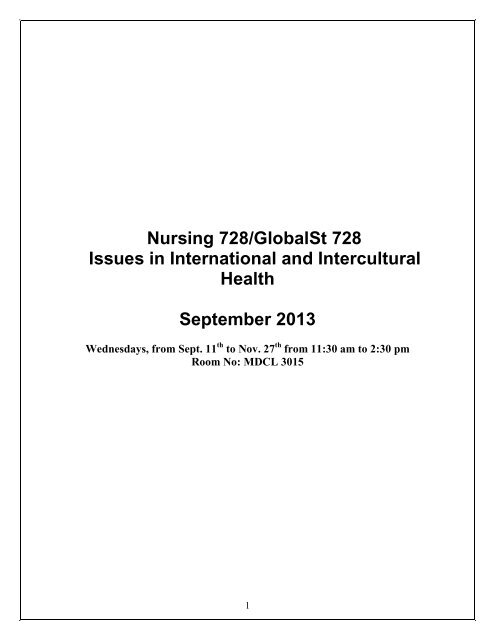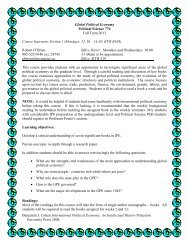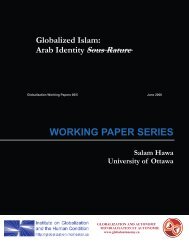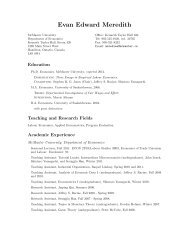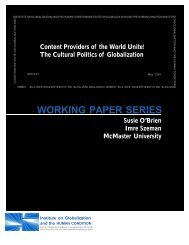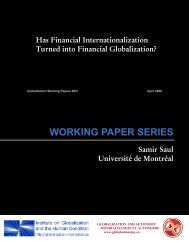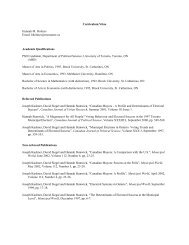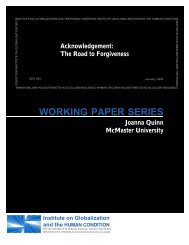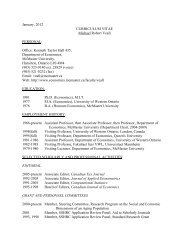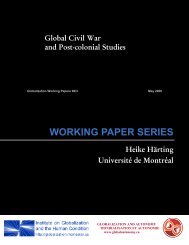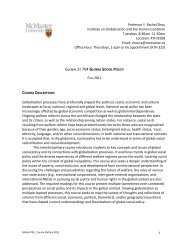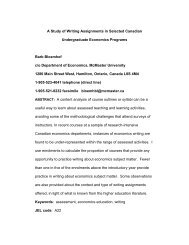Course Outline - McMaster University
Course Outline - McMaster University
Course Outline - McMaster University
Create successful ePaper yourself
Turn your PDF publications into a flip-book with our unique Google optimized e-Paper software.
Nursing 728/GlobalSt 728<br />
Issues in International and Intercultural<br />
Health<br />
September 2013<br />
Wednesdays, from Sept. 11 th to Nov. 27 th from 11:30 am to 2:30 pm<br />
Room No: MDCL 3015<br />
1
<strong>Course</strong> Description:<br />
This course is intended for students who have had little or no professional work<br />
experience in international or intercultural Canadian settings and who desire an<br />
orientation to the priorities, issues and strategies for health and development. The course<br />
will provide students with a structured introduction to health issues in an intercultural<br />
Canadian and international context, and challenge them to build a conceptual framework<br />
that is useful analysing these problems. During this course students will be introduced to<br />
the literature of development, political economy, medical and social anthropology and<br />
international and intercultural theories for nursing practice in these settings.<br />
OVERVIEW<br />
This course provides an introduction to health issues, priorities and strategies for health<br />
and development, concepts and theories relevant to primary health care, culture and<br />
development will be examined. The topics are as follows: dependency and<br />
modernization theories; immigration policies; primary health care; comparing and<br />
contrasting national health care systems; health profile of developing countries and<br />
aboriginal communities; intercultural theories; influence of culture on health beliefs and<br />
practices; alternative and complimentary health care practice; women: their status and<br />
roles in selected countries; participatory development; and, role of international<br />
organizations.<br />
OBJECTIVES<br />
Upon completion of the course, the student will:<br />
1. Analyze the impact of a country’s political, economic and social development on the health of its<br />
population and its health care system.<br />
2. Identify the positive and negative impacts of “modernization” on the health status of a population<br />
or groups within populations.<br />
3. Describe the historical development and relevance of Primary Health Care in Canada and<br />
internationally.<br />
4. Describe Canada’s health care system, including the professional, “folk” and popular sectors, as<br />
well as that of at least one other country, and assess the adequacy of the system to respond to the<br />
defined health needs of the population.<br />
5. Describe how factors such as lifestyle, physical and social environments and biology determine<br />
the health of populations.<br />
6. Critically analyze selected intercultural theories and models and explain their application within a<br />
health care context.<br />
2
7. Define the terms development, equity, capacity-building and sustainability, and identify the role of<br />
health and health care in these processes.<br />
8. Demonstrate beginning understanding of the role of selected Canadian and International<br />
Development organizations and how they impact the health of nations.<br />
<strong>Course</strong> Format:<br />
Topics will be discussed weekly through three-hour seminars.<br />
<strong>Course</strong> Evaluation:<br />
Seminar Performance Pass/Fail Weekly<br />
Presentation 20% Weeks 9 and 11<br />
Major paper 60% Week 7<br />
Individual portfolio 20% Week following<br />
presentation<br />
Total 100%<br />
EVALUATION<br />
1. Give an individual or group presentation on a selected topic (20%)<br />
2. Individual portfolio (20%)<br />
3. A major paper (10-15 pages) representing a critical evaluation of a specific issue (60%)<br />
PRESENTATION<br />
Students present individually or in a group. Each student or the group will decide on a<br />
topic, country or issue to research for a 30 minute presentation (20 minutes presentation,<br />
10 minutes questions/answers) to the class. The presentation may take the form of a<br />
didactic lecture, mini-workshop, seminar, debate, tutorial session or any other form<br />
deemed appropriate. The overall objective is to research the identified health issue and<br />
demonstrate your application of relevant concepts and principles to the understanding and<br />
possible amelioration of the issue. Each student or group will develop evaluation criteria<br />
and a format for the presentation.<br />
3
INDIVIDUAL PORTFOLIO<br />
In additional to the above, each student will submit a portfolio of the work they did in<br />
preparation and implementation of the presentation. This should include:<br />
1. An annotated bibliography of at least six (6) articles (at least 4 of which are NOT on the course<br />
required reading list) which were read in preparation for the presentation or class preparation<br />
2. Each paper will be evaluated based on critical thinking and evidence based criteria<br />
3. A list of the human and/or material resources and strategies used to research the topic for<br />
presentation and paper.<br />
4. Copies of overheads or handouts used (if any) during the presentation.<br />
5. A statement of no more than 250 words describing what you have learned from this course and<br />
how you will be utilizing this knowledge in future.<br />
The portfolio should be handed in one week after the presentation.<br />
ESSAY<br />
Each student will write a paper of no more than 3,000 words (10-20 pages) on a health<br />
issue of international or national relevance. The paper could demonstrate breadth of<br />
knowledge of an issue which crosses boundaries or depth of knowledge of an issue within<br />
one jurisdiction. The overall objective is to demonstrate application of knowledge and (if<br />
possible) synthesis of concepts and principles to the analysis of the issue(s). Papers<br />
which are relevant to the student’s potential clinical placement or any international life<br />
experience are encouraged. APA style is required.<br />
SEMINAR PERFORMANCE (Attendance, accountability to peers and self, evidence<br />
based dialogue)<br />
SEMINAR PROCESS<br />
• Gives you the opportunity to discuss ideas.<br />
• Allows you to argue your point about certain issues.<br />
• Is an opportunity to troubleshoot - it helps you to share and solve issues related to your<br />
study and/or assignments.<br />
• Can be a good opportunity to review lecture and reading material.<br />
• Can be a chance to circulate a document, article or illustration to spark a group<br />
discussion.<br />
• Allows you the opportunity to use the time and expertise of your tutor and your fellow<br />
students to enhance learning.<br />
Expectations<br />
• come to class prepared with questions and critiques of the readings, etc.<br />
• show respect for members of the class, both in speech and manner, and for the method<br />
of shared inquiry and peer discussion.<br />
4
• contribute to the discussion by raising thoughtful questions, analyze relevant issues,<br />
build on others’ ideas, synthesize across readings and discussions, expand the class’s<br />
perspective, and appropriately challenge assumptions and perspectives.<br />
Chambers, E. and Northedge, A. 1997. The Arts Good Study Guide. Milton Keynes: The<br />
Open <strong>University</strong>.<br />
Wareing, S., May, L. and O'Neill, R. 2001. How to StudySuccessfully. 2nd ed. Newport:<br />
<strong>University</strong> of Wales College, Newport.<br />
Text books<br />
Required:<br />
Seear, M. (2007). An Introduction to International Health. Toronto: Canadian Scholars’<br />
Press Inc.<br />
Articles: (2012- 2013)<br />
1. Health Equity Through Action - Social Determinants of Health: Summary<br />
document: http://bit.ly/17ygPsr: Four briefs on the following themes:Race,<br />
Racism and the Social Determinants of Health http://bit.ly/145dvjH ; Urban Health<br />
Building Human Capital: A Community’s Greatest Resource http://bit.ly/14t6s3l ; Urban<br />
Health Policies That Have Altered the Landscape http://bit.ly/11WnHXy; Place and<br />
Health: Building Healthy Communities to Reduce Health Disparities http://bit.ly/10gsHda .<br />
2. A history of the humanitarian system - Western origins and foundations; Eleanor Davey,<br />
with John Borton and Matthew Foley; HPG Working Paper - June 2013;Overseas<br />
Development Institute ODI – London, United Kingdom; Available online at:<br />
http://bit.ly/14sGa17.<br />
3. Health financing for universal health coverage : Bulletin of the World Health Organization<br />
- 17 June 2013; Joseph Kutzin; Health Systems Financing, World Health Organization,<br />
Geneva,Switzerland; Available online at: http://bit.ly/14T2wuJ.<br />
4. Marketing of foods high in fat, salt and sugar to children: update 2012–2013; WHO<br />
Regional Office for Europe; Copenhagen, Denmark – June 2013; Available online at:<br />
http://bit.ly/19V3TwL<br />
5. Global and regional estimates of violence against women: Prevalence and health effects<br />
of intimate partner violence and non-partner sexual violence; WHO, Department of<br />
Reproductive Health and Research – June, 20, 2013 Website: http://bit.ly/180oO0F Full<br />
report PDF [51p.] at: http://bit.ly/11AKgCe<br />
6. Dark Sides of the Proposed Framework Convention on Global Health's Many Virtues: A<br />
Systematic Review and Critical Analysis; Steven J. Hoffman, <strong>McMaster</strong> <strong>University</strong>,<br />
Canada, and Harvard <strong>University</strong>, USA; John-Arne Røttingen, <strong>University</strong> of Oslo, Norway,<br />
and Harvard <strong>University</strong>, USA; Health & Human Rights Journal 15(1):117-134. – June<br />
2013; Available online at: http://bit.ly/104W8yx<br />
7. Environmental Scan of Patient Safety Education and Training Programs: Agency for<br />
Healthcare Research and Quality - U.S. Department of Health and Human Services’<br />
Rockville, MD USA – June 2013; Available online at: http://1.usa.gov/16dT5Fo<br />
8. Mapping the regulatory architecture for health care delivery in mixed health systems in<br />
low- and middle-income countries; Kabir Sheikh, Prasanna Saligram, Lakshmi E.<br />
PrasadPublic Health Foundation of India; Nossal Institute for Global Health, 2013 -<br />
<strong>University</strong> of Melbourne ; Available online at: http://bit.ly/16Eqx8J.<br />
9. Proceedings of the Second Pan American Conference on Obesity with special attention<br />
to childhood obesity and a workshop: ‘Education for childhood obesity prevention: A life-<br />
5
course approach’ at PACO II; International Journal of Obesity; Volume 3 Supplement 1 -<br />
June 2013; Available online at http://goo.gl/lauv1; R Visser and R L Atkinson; Int J Obes<br />
Supp 3: S1-S2; doi:10.1038/ijosup.2013.1<br />
10. Policymakers’ and other stakeholders’ perceptions of key considerations for health<br />
system decisions and the presentation of evidence to inform those considerations: an<br />
international survey: Joshua P Vogel 1,2, Andrew D Oxman3 , Claire Glenton 3, Sarah<br />
Rosenbaum 3, Simon Lewin 3,4, A Metin Gülmezoglu 2, João Paulo Souza; Health<br />
Research Policy and Systems 2013, 11:19 doi:10.1186/1478-4505-11-19 – May 24,<br />
2013. Available online at: http://bit.ly/118o1Gg<br />
11. Socioeconomic Inequality in Disability Among Adults: A Multicountry Study<br />
Using the World Health Survey. American Journal of Public Health – 2013;<br />
Ahmad R. Hosseinpoor, Alana Officer, Emese Verdes, Nenad Kostanjsek, and<br />
Somnath Chatterji Website: http://bit.ly/11eWNiS<br />
12. Principles for research on ethnicity and health: the Leeds Consensus Statement: Ghazala<br />
Mir1, Sarah Salway2, Joe Kai3, Saffron Karlsen4, Raj Bhopal5, George TH Ellison6, Aziz<br />
Sheikh5; European Journal of Public Health, Vol. 23, No. 3, 504–510; Published by<br />
Oxford <strong>University</strong> Press; Available online at: http://bit.ly/10Tof46.<br />
13. Rethinking the politics and implementation of health in all – HIAP: Matthias<br />
Wismar, David McQueen, Vivian Lin, Catherine M Jones and Maggie Davies;<br />
Rethinking the politics and implementation of health in all – HIAP.<br />
14. 21 Issues for the 21st Century : United Nations Environment Programme UNEP –<br />
February 2012; Results of the UNEP Foresight Process on Emerging Environmental<br />
Issues; Available online PDF file [60p.] at: http://bit.ly/zNKhAV.<br />
Program Resources:<br />
1. The Global Health Education Consortium > Teaching Modules > 61: Why is The Third World The Third<br />
World?<br />
2. The Global Health Education Consortium > Teaching Modules > 29: Global Health in Historical<br />
Perspective<br />
The Uses of History.<br />
3. The Global Health Education Consortium > Teaching Modules > 21: Global Burden of Disease:<br />
Magnitude and Measures.<br />
4. The Global Health Education Consortium > Teaching Modules > 20: Global Health and Development The<br />
Basics.<br />
5. . The Global Health Education Consortium > Teaching Modules > 27: Primary Health Care: Past, Present<br />
and Future.<br />
6. The Global Health Education Consortium > Teaching Modules > 22: Global Health 'Actors' And Their<br />
Programs.<br />
7. The Global Health Education Consortium > Teaching Modules > 71: Health Workforce: Training of<br />
Community Health Workers.<br />
Media:<br />
http://www.cbc.ca/ Canadian Broadcasting Corporation news website<br />
http://www.bbc.co.uk/ British Broadcasting Corporation news website<br />
http://www.newyorker.com/ The New Yorker magazine website<br />
http://www.economist.com/index.html The Economist magazine website<br />
6
http://www.macleans.ca/ Macleans magazine website<br />
http://www.time.com/time/ Time magazine website<br />
http://www.csmonitor.com/ The Christian Science Monitor Newspaper Website<br />
http://www.theglobeandmail.com/ The Globe and Mail Newspaper Website<br />
http://www.nytimes.com/ The New York Times Newspaper Website<br />
http://www.nationalgeographic.com/ National Geographic Magazine Website<br />
Government:<br />
http://www.canada.gc.ca/main_e.html Canadian Government Website (including Health Canada<br />
links)<br />
http://www.canadainternational.gc.ca/index.aspx?lang=en Canada International<br />
http://www.international.gc.ca/index.aspx Canadian Foreign Affairs<br />
http://www.ainc-inac.gc.ca/index-eng.asp Indian and Northern Affairs Canada<br />
http://www.acdi-cida.gc.ca/cidaweb/acdi Canadian International Development Agency (CIDA)<br />
http://www.un.org/ United Nations Website<br />
http://www.worldbank.org/ World Bank Website<br />
http://www.who.int/en/ World Health Organization Website<br />
Other:<br />
http://www.edchange.org/projects.html Professional Development, Scholarship, Activism for<br />
Diversity, Social Justice and Community Growth<br />
http://www.aed.org/ Academy for Educational Development<br />
http://www.ghwatch.org/index.php Global Health Watch Website<br />
http://www.milbank.org/index.html Milbank Memorial Fund<br />
http://www.cfr.org/issue/40/nongovernmental_organizations.html Council on Foreign Relations<br />
http://www.wango.org/default.aspx World Association of Non-Governmental Organizations<br />
(WANGO)<br />
7
Nursing 728<br />
Sept. 11 th to Dec. 4th<br />
Week 1<br />
Sept. 11th<br />
Week 2<br />
Sept. 18th<br />
Week 3<br />
Sept. 25th<br />
Week 4<br />
Oct.2nd<br />
Week 5<br />
Oct. 9th<br />
Week 6<br />
Oct. 16th<br />
Week 7<br />
Oct. 23rd<br />
Week 8<br />
Oct. 30th<br />
Week 9<br />
Nov. 6th<br />
Week 10<br />
Nov. 13th<br />
Week 11<br />
Nov. 20th<br />
Week 12<br />
Nov.27th<br />
Introduction to International Health: Scope and Nature of <strong>Course</strong> &<br />
History of Development<br />
Basanti Majumdar<br />
Theories and Concepts of Development<br />
Discussion: Basanti Majumdar<br />
Readings & (Video by Prof. Michael Ladouceur)<br />
Global Health Care Systems and Priorities<br />
Discussion: Basanti Majumdar<br />
Readings & (Video by Prof. Michael Ladouceur)<br />
Canada’s Contribution to International Health<br />
Student Debate: Pro & Con.<br />
Basanti Majumdar<br />
Individual and Group consultation:<br />
Major paper and presentation<br />
Basanti Majumdar<br />
Priority Populations - Maternal and Migrants & Refuges Health<br />
Prof. Jodi Pipes<br />
<strong>McMaster</strong> <strong>University</strong>, School of Nursing<br />
Mid-term evaluations<br />
Capacity Building and Sustainability Community involvement<br />
Participatory Research<br />
Basanti Majumdar<br />
Major paper due<br />
PHC in Under-serviced Communities: Theory in Practice<br />
Speaker: Dr. Zari Gill, Director Infectious Diseases I Global Health<br />
& WASH Team| World Vision International<br />
Student Presentation<br />
Student Presentation<br />
Student Presentation<br />
Priority Populations - Aboriginal & Metis people Health<br />
Danielle N. Soucy, MA<br />
Director & Program Coordinator<br />
Aboriginal Students Health Sciences (ASHS) & Assistant Clincial<br />
Professor (Adjunct) Dept. Family Medicine<br />
Student Presentation<br />
Wrap up<br />
final evaluation<br />
Portfolio Due<br />
Portfolio Due<br />
8
Session 1<br />
Introduction to International Health: Scope and Nature of the <strong>Course</strong><br />
History of Development<br />
Objectives<br />
1. To provide an overview of the scope, objectives, format and expectations for the course.<br />
2. To introduce the faculty and students to each other.<br />
3. To review the historical determinants of the global development and the impact of<br />
globalization on the health of the people.<br />
4. To identify the students’ interests and experiences and match with potential clinical<br />
placements based on geographical, cultural and/or clinical areas of interest.<br />
Key Concepts: development, developing countries, less industrialized countries<br />
Suggested Tutorial Activities<br />
1. <strong>Outline</strong> the course expectations and format including roles, expectations and plans of the<br />
students and tutors in the literature to be examined.<br />
2. Introduce participants’ areas of knowledge and experience, personal objectives in taking<br />
course, and identification of possible clinical placements.<br />
3. Introduce and discuss different “views” of the world with particular reference to “developing”<br />
countries and vulnerable populations.<br />
Required Readings<br />
Seear, M. (2007). An Introduction to International Health. Parts I. & II (p. 3-73). Toronto:<br />
Canadian Scholars’ Press Inc.<br />
Recommended Readings<br />
Hanson, K, Ranson, MK, Oliveira-Cruz, V, & Mills, A. (2003). Expanding access to<br />
Priority health interventions: A framework for understanding the constraints to scaling<br />
up. Journal of International Development, 15, 1-4.<br />
Juma, C & Yee-Cheong, L. (2005). Reinventing global health: the role of science,<br />
technology and innovation. The Lancet. Available at:<br />
http://www.unmilliniumproject.org/documents/TheLancet_sci_tech.pdf<br />
Keppel K, Pamuk E, Lynch J, et al. (2005). Methodological issues in measuring health<br />
disparities, National Center for Health Statistics. Vital Health Stat 2(141).<br />
Available at: http://www.cdc.gov/nchs/data/series/sr02_141.pdf<br />
Todaro, M. P. & Smith, S. C. (2009). Economics, institutions and development: A global<br />
perspective. In M.P. Todaro & S.C. Smith (Eds.). Economic Development (10th ed), (pp. 2-38).<br />
Toronto: Addison -Wesley.<br />
9
On-Line References<br />
Global Health Watch Report 2007<br />
http://www.ghwatch.org/GHW2007_8.php<br />
The Future of Academic Medicine: Five Scenarios to 2025:<br />
http://www.milbank.org/reports/0507FiveFutures/0507FiveFutures.html<br />
The Interaction between Democracy and Development. Available at:<br />
http://unesdoc.unesco.org/images/0013/001323/132343e.pdf<br />
Public Health Mapping and GIS, Communicable Diseases, World Health Organization.<br />
2007<br />
http://www.who.int/entity/whosis/whostat2007<br />
World Health Statistics 2007-2011<br />
http://www.euro.who.int/document/e89383.pdf - part 1<br />
http://www.euro.who.int/document/e89384.pdf - part 2<br />
Seminar Activity<br />
<br />
Discussion to prepare for the course<br />
10
Session 2<br />
Theories and Concepts of Development<br />
Objectives<br />
1. To examine several models of development.<br />
2. To introduce theories and concepts in development and the values and beliefs which underlay<br />
these.<br />
3. To critically challenge assumptions about development in Canada and internationally.<br />
4. To discuss how development projects may have a harmful as well as a beneficial effect on<br />
populations.<br />
5. To explore the concept of sustainability in development.<br />
6. To describe examples of effective development projects; considering what is meant by<br />
“effective” and who determines this.<br />
Key Concepts: colonization, democratization, dependency, modernization, gender in<br />
development, non-governmental organizations, structural adjustment<br />
Readings<br />
Connelly, MP, Murray Li, T, McDonald, M, & Parpart, JL. (1995). Restructured<br />
Worlds/Restructured Debates: Globalization, Development and Gender. In B<br />
Levy & C Andrews (Eds.) Canadian Journal of Development.Studies - Special<br />
Issue (pp. 15-38).<br />
Seear, M. (2007). An Introduction to International Health. Part IV. Toronto: Canadian<br />
Scholars’ Press Inc.<br />
On Line Lecture<br />
“Theories of Development” and “Theories of Development, 2007”<br />
Speaker: Dr. Gary Warner<br />
References<br />
De Paula, S, & and Dymski, GA., Eds. (2005). Remaining Growth - Towards a Renewal<br />
of Development Theory. London: Zed Books Inc.<br />
Dower, N. (2005). Development and Globalization: the Ethical Challenges. Martin<br />
Benjamin Distinguished Lecture Michigan State <strong>University</strong>. Available at:<br />
http://www.msu.edu/unit/phl/devconference/DowerE&Dv3.pdf<br />
McCoy, D, Bambas, L, & et al. (2003). Global Equity Gauge Alliance: Reflections on<br />
Early experiences. J Health Popul Nutr, 21(3), 273-287.<br />
Ramalingam, B. (2005). Implementing knowledge strategies: Lessons from<br />
international development agencies. Working Paper 244. London: Overseas<br />
11
Development Institute.<br />
Sachs, J. (2005). The End of Poverty: Economic Possibilities for Our Time. Penguin<br />
Group. Available at:<br />
http://www.earthinstitute.columbia.edu/endofpoverty/index.html<br />
Tadaro, M. (1997). Theories of Development: A Comparative Analysis. In Tadaro, M.<br />
Seminar Activity<br />
1. Applying Development Theories to Strategies in Global Health and Development<br />
Student will receive case scenarios from developing and more industrialized countries,<br />
describing different strategies for development. In sub-groups, students will:<br />
i. describe the “development project” (students pick at least one project from a low income<br />
country to contrast with a more industrialized country)<br />
ii. discuss what values underlie the development strategy i.e. local ownership, collective vs.<br />
individual benefits, support for the environment, equity, social justice, etc.<br />
iii. discuss how the strategy/intervention will contribute to sustainable development - for<br />
whom?<br />
iv. debate whether the strategy could be applied in our local context.<br />
2. Student will break into groups to discuss development theories based on reading and network<br />
searches, and do mini presentations about 10 minutes of planning. Students will use<br />
appropriate Av materials like white board/power point.<br />
12
DEVELOPMENT MEANS<br />
Below is a list of statements about development. Read through the list.<br />
1. Draw a line through statements with which you can agree.<br />
2. Put a check mark (√) next to the statements that define development correctly.<br />
3. Circle the definition that is the most important.<br />
Development is…<br />
___ the realization of social, political and economic rights<br />
___ recognizing our interdependence with others<br />
___ technological advancement<br />
___ redistribution of wealth<br />
___ equal opportunity for all<br />
___ an increase in gross national product<br />
___ integrating the underdeveloped world into the modern world economy<br />
___ the result of initiative, hard work and entrepreneurial skills<br />
___ dealing with third world overpopulation problems<br />
___ transforming social and political structures<br />
___ rectifying unjust economic relations between rich and poor<br />
___ the meeting of basic human needs (e.g. adequate food)<br />
___ enabling people’s self determination<br />
___ a measure of a certain standard of living<br />
___ a new international economic order<br />
___ ending racism and sexism<br />
___ national self-determination and self-reliance, free of foreign intervention<br />
___ freedom from oppression<br />
___ increasing the world food supply<br />
___ helping people who are less well off<br />
___ supporting national liberation struggles<br />
other_________________________________________________________________<br />
Exercise taken from:<br />
Huntly, A. (1987). Development means. In Development is…an introduction study kit on<br />
development. Ottawa, Canada: CUSO. Experience One.<br />
13
Session 3<br />
Health Care Systems and Priorities<br />
Objectives:<br />
1. Situate the development of a national health care system within the current sociopolitical<br />
reality.<br />
2. Identify the impact of economic and political forces on the development of a<br />
health care system.<br />
3. Identify national and international issues that impact on the health status of a<br />
nation.<br />
Key concepts: Global Health, WHO, PAHO, Millennium Development Goals;<br />
Neoliberalism, NAFTA, Public/Private Mix<br />
Readings<br />
Article/framework for analyzing a HCS; Seear Text<br />
Seminar activities<br />
Select a global health care issue and discuss the historical and current response of a national<br />
health system of your choice. Consider regional, national and international impact.<br />
On-Line References<br />
Boutros-Ghali, B. (2003). The Interaction between Democracy and Development.<br />
Available at: http://unesdoc.unesco.org/images/0013/0013243e.pdf<br />
Blagescu, M., & Young, J. (2005). Partnerships and Accountability: Current<br />
thinking and approaches among agencies supporting Civil Society Organizations,<br />
Working Paper 255. London: Overseas Development Institute. Available at:<br />
http://www.odi.org.uk/publications/working_papers/wp255.pdf<br />
Case, A, Paxton, C & Vogl, T. (May 2006) Socioeconomic Status and Health in<br />
Childhood: A comment on Chen, Martin & Matthews (2006). National Bureau of<br />
Economic Research. Working Papers Series. Available at:<br />
http://www.princeton.edu/~rpds/downloads/case_paxson_vogl_15090%20w12267.pdf<br />
Dresch, N, Dolea, C, Dal Poz, MR, Govharev, A, Adams, O et al. (2005). An approach to<br />
estimating human resource requirements to achieve the Millennium Development<br />
Goals. Health Policy & Planning 20(5), 267-276. Available at:<br />
http://heapol.oxfordjournals.org/cgi/content/abstract/20/5/267<br />
OECD (February 2005). Forum on Partnerships for More Effective Development. Available at:<br />
http://www.oecd.org/document/49/0,2340,en_2649_33721_34060145_1_1_1_1,00.html<br />
14
Sen, A. (2005). Ethics, Development and Disaster. Available at:<br />
http://www.iadb.org/etica/sp4321/DocHit.cfm?DocIndex=2062<br />
Sachs, J. (2004) Health in the developing world: Achieving the Millennium<br />
Development Goals. Bulletin of the World Health Organization, 82(12), 947-949.<br />
Available at: http://www.who.int/bulletin/volumes/82/12/en/947.pdf<br />
Tschirgi, N. (2005). Peace Building through Global Peace and Development.<br />
Development, 48(3), 50-56. Available at:<br />
http://www.palgrave-journals.com/development/journal/v48/n3/pdf/1100163a.pdf<br />
World Bank Institute (2005). Special Report: Reaching the Poor with Health Development<br />
Outreach: Putting knowledge to work for development. Available at:<br />
http://www1.worldbank.org/devoutreach/may05/index.asp<br />
World Development Report 2006<br />
http://siteresources.worldbank.org/EXTWDR2011/Resources/6406082-<br />
1256239015781/WDR_2011_Overview.pdf<br />
World Development Report 2006 on Equity and Development. Available at<br />
http://www.worldbank.org/wdr2006<br />
In preparation for participation in weekly seminars, please view lectures and<br />
presentations available at the following website:<br />
http://www.learnlink.mcmaster.ca/Login/WWW/bscn/courses/n4h03/index.html<br />
15
Session 4<br />
Canada’s Contribution to International/Global Health<br />
Objectives<br />
1. Review of Canadian International Agencies (CIDA, IDRC, MSF)<br />
2. Examine categories of project contribution<br />
3. Explore methods to evaluate the impact of the activities<br />
4. Explore the impact of events on funding priorities for health<br />
Key Concepts: international/Global health, health agencies, funding<br />
Readings<br />
Black, C, McGrail, K et al., (2005). Data, Data, Everywhere…: Improving access to<br />
population health and health services research data in Canada. Health Network, CPRN,<br />
Final Report. Available at: http://www.cprn.org/documents/36948_en.pdf<br />
Seear, M. (2007). An Introduction to International Health. Parts III & IV (p. 99-237).<br />
Toronto: Canadian Scholars’ Press Inc.<br />
On Line Lectures<br />
“Canadian Coalition for Global Health Research (CCGHR)”<br />
Speaker: Dr. Victor Neufeld<br />
“Canada’s Contribution to International Health”<br />
Speaker: Dr. Andrea Baumann<br />
On-Line References<br />
Exploring the 70/30 Split: How Canada's Health Care System Is Financed – Available at:<br />
http://secure.cihi.ca/cihiweb/disPage.jsp?cw_page=PG_469_E&cw_topic=469&cw_rel=<br />
AR-1282_E<br />
Global Health Research Institute Website: http://www.cihr-irsc.gc.ca/e/193.html<br />
Canadian Coalition for Global Health Research online lecture available at:<br />
http://;earnlink.mcmaster.ca/Login/_www/bscn/courses/NH4H03<br />
Canadian Coalition for Global Health Research. Website: http://www.ccghr.ca<br />
<strong>McMaster</strong> <strong>University</strong> Systems-Linked Research Unit on Health and Social Services<br />
Utilization http://www.fhs.mcmaster.ca/slru<br />
Community-Linked Evaluation AIDS Resource: http://www.fhs.mcmaster.ca/slru/clear<br />
16
<strong>McMaster</strong>-Lancet Challenge Conference: Peace through Health: Learning from Action<br />
(2005). Centre for Peace Studies and Population Health Research Institute.<br />
Available at: http://www.humanities.mcmaster.ca/peace-health/Conf2005.htm<br />
Seminar Activity<br />
<br />
<br />
Discuss lecture & readings<br />
Discuss articles from “current events” related to Canada’s role in international<br />
development<br />
17
Session 5<br />
Individual and Group consultation:<br />
Major paper and presentation<br />
1. Please come with your topic for Presentation and Major paper<br />
2. Discuss your rational for selecting the topic for both assignments<br />
3. Share your ideas for presentation of your presentation session<br />
4. Bring an outline of your reference<br />
18
Session 6 A<br />
Priority Populations: Maternal Health<br />
Objectives:<br />
1. To gain an appreciation of the relationship between social inequality, health and<br />
development.<br />
2. To explore the evolution of development frameworks that address inequality and health (e.g.<br />
WID, WAD, GAD, MDGs).<br />
3. To examine ways of promoting health and education of women and girls in selected<br />
cultural contexts.<br />
Key terms: gender, immigration, economic status, power<br />
Suggested Tutorial Activities<br />
A variety of large group and small group exercises will be used to demonstrate the intricacy of<br />
gender as a determinant of the health of women, their families and their communities.<br />
Required Readings<br />
Seear, M. (2007). An Introduction to International Health. Part V (p. 143-258). Toronto:<br />
Canadian Scholars’ Press Inc.<br />
Asada, Y. (2005). A framework for measuring health inequity. Journal of<br />
Epidemiology and Community Health. Available at:<br />
http://jech.bmjournals.com/cgi/content/full/59/8/700<br />
Additional References<br />
Baldyga, W. & Petersmarck, K. (2005). Reducing health disparities: what is being<br />
done, what works. Prev Chronic Diseases (2) 2. Available from:<br />
http://www.cdc.gov/pcd/issues/2005/apr/05_0002.htm<br />
Belli, PC, Bustreo, R, & Preker, A. (2005). Investing in children’s health: what are the<br />
economic benefits? Bulletin of the World Health Organization, 83 (10), 721–800.<br />
Available at: http://www.who.int/bulletin/volumes/83/10/777/pdf<br />
Bryant, J. (2005). Children of international migrants in Indonesia, Thailand, and the<br />
Philippines: a review of evidence and policies, Innocenti Working Paper No. 005-<br />
05. Florence, UNICEF Innocenti Research Centre. Available at:<br />
http://www.unicef-icdc.org/publications/pdf/iwp2005_05.pdf<br />
Connelly, P, Murray LT, MacDonald, M & Parpart, J. (1995). Restructured worlds,<br />
restructured debates: globalization, development and gender. Canadian Journal<br />
of Development Studies, Special Edition, 17-38.<br />
Freedman, LP, Waldman, RJ, de Pinho, H, Wirth, ME, Mushtaque, A, Chowdhury, R &<br />
19
Rosenfield, A. (March 2005). Transforming health systems to improve the lives of<br />
women and children. The Lancet, March 2005. Available at:<br />
http://www.unmillemiumproject.org/docuemnts/TheLancetChildHealthMaternallHealth.p<br />
df<br />
Grown, C, Gupta, GR & Pa, R. (2005). Taking action to improve women’s<br />
health through gender equality and women’s empowerment. The Lancet. Available at:<br />
http://www.unmillenniumproject.org/documents/TheLancetGender.pdf<br />
Ljung, R, Peterson, S, Hallqvist, J, Heimerson, I, & Diderichsen, F. (February 2005). Are<br />
poor people less healthy? Socioeconomic differences in the burden of disease in<br />
Sweden. Bulletin of the World Health Organization, 83 (2). Available at:<br />
http://www.who.int/bulletin/volumes/83/2/en/92.pdf<br />
Mackenbach, JM & Stronks, K. (2004) International Journal for Equity in Health,<br />
3(11). Available at: http://www.equityhealthj.com/content/3/1/11<br />
McIntyre, S, Hunt, K & Sweeting, H. (1996). Gender differences in health: are things<br />
really as simple as they seem? Soc.Sci.Med. 42(4), 617-624.<br />
Rajani, A. (1995). Evaluating experience: CIDA’s Women in Development Policy, 1984-<br />
94. Canadian Journal of Development Studies, Special Edition, 79-88.<br />
Santow, G. (1995). Social roles and physical health: the case of female disadvantage in<br />
poor countries. Soc.Sci.Med. 40, 147-161.<br />
Scott, C. (1995). Gender and Development: Rethinking Modernization and Dependency<br />
Theory. Denver, CO: Lynne Reinner Pub.<br />
Stephens, C, Porter, J, Nettleton, C & Willis, R. (17 June 2006). Disappearing,<br />
displaced, and undervalued: a call to action for Indigenous health worldwide. The Lancet<br />
367 (9527), 2019-2028. Available at:<br />
http://download.thelancet.com/pdfs/journals/0140-6736/PIIS0140673606688922.pdf<br />
Tackling Health Inequalities: Governing for Health Summit<br />
http://www.dh.gov.uk/PolicyAndGuidance/International/EuropeanUnion/EUPresidency2<br />
005/EUPresidencyArticle/fs/en?CONTENT_ID=4119613&chk=Xa2sOh<br />
Visvanathan, N. (Ed.) (1997). Survey of theoretical debates. In Visvanthathan, N. (Ed.)<br />
The Women, Gender and Development Reader. Halifax, NS: Fenwood<br />
Publishing Ltd., pp. 17-32.<br />
Pond, B & McPake, B. (2006). The health migration crisis: the role of four<br />
Organizations for Economic Cooperation and Development countries. The Lancet,<br />
367(9520). Available at:<br />
http://www.theolancet.com/journals/lancet/article/PIIS0140673606683463/fulltext<br />
20
On-Line Reference<br />
Pan American Health Organization http://www.oecd.org/dac/gender<br />
Reproductive Health/Pregnancy/STDs http://www.fhi.org/en/ctu/adoltpm/main.htm<br />
Latin American Health Reform<br />
http://www.contracts.health-sector-reform.org<br />
http://www.americas.health-sector-reform.org<br />
Coalition for Research in Women’s Health http://www.CRWH.org<br />
Center for Social Epidemiology and Population Health http://www.sph.umich.edu/cseph<br />
Combining Qualitative and Quantitative Approaches in Poverty Analysis<br />
http://www.q-squared.ca<br />
Family Health International. Reproductive Health/Pregnancy/STDs<br />
http://www.fhi.org/en/ctu/adoltpm/main.html<br />
Gender Equality and Development (OECD) http://www.oecd.org/dac/gender<br />
Health Care Reform: Canada in an International Setting .http://www.cprn.org/en<br />
Human Security Report – Follows trends of Political Violence<br />
http://www.humansecurityreport.info<br />
International Society for Equity in Health: 2006 Post Conference Information<br />
http://www.iseqh.org/index_en.htm<br />
Progress of the World’s Women 2005: Women, Work & Poverty,” UNIFEM United<br />
Nations Development Fund for Women. Available at:<br />
http://www.unifem.org/attachments/products/PoWW2005_overview_eng.pdf<br />
Tackling Health Inequalities: Status Report on the Programme for Action. Department of<br />
Health. England, 11 August 2005. Report available at:<br />
http://www.dh.gov.uk/assetRoot/04/11/76/98/04117698.pdf<br />
WHO (May 2005). Towards a Conceptual Framework for Analysis and Action on the<br />
Social Determinants of Health. WHO Commission on Social Determinants of<br />
Health. Cairo. Available at:<br />
http://ftp.who.int/eip/commission/Cairo/Meeting/CSDH%20Doc%20%20%20Conceptual<br />
%20framework.pdf<br />
UNDP (2005) Discussion on the Gender-related Development Index (GDI) and the<br />
Gender Empowerment Measure (GEM). United Nations Development<br />
Programme. Available at:<br />
http://hdr.undp.org/network/messageview.cfm?catid=8&threadid=100<br />
UNFPA (2005) State of the World Population. Available at:<br />
http://www.unfpa.org/swp/2005/pdf/en/_swp05.pdf<br />
21
UNICEF (2007) The State of the World’s Children. Executive Summary available at:<br />
http://www.unicef.org/publications/files/The_State_of_the_Worlds_Children_2007Execu<br />
tive_Summary_E.pdf<br />
UNICEF (2007) State of the World’s Children 2007 Quiz. Available at:<br />
http://www.unicef.org/sowc07/quiz/index.html<br />
UNRISD Report on Gender Equality: Striving for Justice in an Unequal World (<br />
2005). Progress for Children: A Report Card on Gender Parity and Primary<br />
Education (2).UNICEF. Available at:<br />
http://www.unicef.org/publications files/PFC2_rev_July_2005_3506_Eng_01.pdf<br />
British Medical Association (2006). Poverty and deprivation – key causes of mental<br />
Health problems in children. Available at:<br />
http://www.bma.org.uk/ap.nsf/Content/Childadolescentmentalhealth<br />
World Forum on Human Rights (2006) 2 nd World Forum on Human Rights. Nantes,<br />
France. Available at: http://www.forum-humanrights.org<br />
22
Objectives:<br />
Session 6B<br />
Priority Populations: Migrants & Refugees Health<br />
1. To discuss the contribution of “high risk” individuals to the economic welfare of<br />
society.<br />
2. To differentiate between individual and systemic inequity based on gender, age, and<br />
citizenship and its implications in the determination and resource allocation to priority<br />
health problems globally.<br />
Key terms: gender, immigration, economic status, power<br />
Suggested Tutorial Activities<br />
A variety of large group and small group exercises will be used to demonstrate the intricacy of<br />
gender as a determinant of the health of women, their families and their communities.<br />
Required Readings<br />
Seear, M. (2007). An Introduction to International Health. Part V (p. 143-258). Toronto:<br />
Canadian Scholars’ Press Inc.<br />
Asada, Y. (2005). A framework for measuring health inequity. Journal of<br />
Epidemiology and Community Health. Available at:<br />
http://jech.bmjournals.com/cgi/content/full/59/8/700<br />
Additional References<br />
Baldyga, W. & Petersmarck, K. (2005). Reducing health disparities: what is being<br />
done, what works. Prev Chronic Diseases (2) 2. Available from:<br />
http://www.cdc.gov/pcd/issues/2005/apr/05_0002.htm<br />
Belli, PC, Bustreo, R, & Preker, A. (2005). Investing in children’s health: what are the<br />
economic benefits? Bulletin of the World Health Organization, 83 (10), 721–800.<br />
Available at: http://www.who.int/bulletin/volumes/83/10/777/pdf<br />
Bryant, J. (2005). Children of international migrants in Indonesia, Thailand, and the<br />
Philippines: a review of evidence and policies, Innocenti Working Paper No.<br />
2005-05. Florence, UNICEF Innocenti Research Centre. Available at:<br />
http://www.unicef-icdc.org/publications/pdf/iwp2005_05.pdf<br />
Connelly, P, Murray LT, MacDonald, M & Parpart, J. (1995). Restructured worlds,<br />
restructured debates: globalization, development and gender. Canadian Journal<br />
of Development Studies, Special Edition, 17-38.<br />
Freedman, LP, Waldman, RJ, de Pinho, H, Wirth, ME, Mushtaque, A, Chowdhury, R &<br />
Rosenfield, A. (2005). Transforming health systems to improve the lives of<br />
women and children. The Lancet, March 2005. Available at:<br />
http://www.unmillemiumproject.org/docuemnts/TheLancetChildHealthMaternallHealth.p<br />
df<br />
Grown, C, Gupta, GR & Pa, R. (2005). Taking action to improve women’s<br />
health through gender equality and women’s empowerment. The Lancet.<br />
23
Available at:<br />
http://www.unmillenniumproject.org/documents/TheLancetGender.pdf<br />
Ljung, R, Peterson, S, Hallqvist, J, Heimerson, I, & Diderichsen, F. (2005). Are<br />
poor people less healthy? Socioeconomic differences in the burden of disease in<br />
Sweden. Bulletin of the World Health Organization, 83 (2). Available at:<br />
http://www.who.int/bulletin/volumes/83/2/en/92.pdf<br />
Mackenbach, JM & Stronks, K. (2004) International Journal for Equity in Health,<br />
3 (11). Available at: http://www.equityhealthj.com/content/3/1/11<br />
McIntyre, S, Hunt, K & Sweeting, H. (1996). Gender differences in health: are things<br />
really as simple as they seem? Soc.Sci.Med. 42(4), 617-624.<br />
Rajani, A. (1995). Evaluating experience: CIDA’s Women in Development Policy, 1984-<br />
94. Canadian Journal of Development Studies, Special Edition, 79-88.<br />
Santow, G. (1995). Social roles and physical health: the case of female disadvantage in<br />
poor countries. Soc.Sci.Med. 40, 147-161.<br />
Scott, C. (1995). Gender and Development: Rethinking Modernization and Dependency<br />
Theory. Denver, CO: Lynne Reinner Pub.<br />
Stephens, C, Porter, J, Nettleton, C & Willis, R. (2006). Disappearing,<br />
displaced, and undervalued: a call to action for Indigenous health worldwide. The<br />
Lancet 367 (9527), 2019-2028. Available at:<br />
http://download.thelancet.com/pdfs/journals/0140-6736/PIIS0140673606688922.pdf<br />
Tackling Health Inequalities: Governing for Health Summit<br />
http://www.dh.gov.uk/PolicyAndGuidance/International/EuropeanUnion/EUPresidency2<br />
005/EUPresidencyArticle/fs/en?CONTENT_ID=4119613&chk=Xa2sOh<br />
Visvanathan, N. (Ed.) (1997). Survey of theoretical debates. In Visvanthathan, N. (Ed.)<br />
The Women, Gender and Development Reader. Halifax, NS: Fenwood<br />
Publishing Ltd., pp. 17-32.<br />
Pond, B & McPake, B. (2006). The health migration crisis: the role of four<br />
Organizations for Economic Cooperation and Development countries. The<br />
Lancet, 367(9520). Available at:<br />
http://www.theolancet.com/journals/lancet/article/PIIS0140673606683463/fulltext<br />
On-Line Reference<br />
Pan American Health Organization http://www.oecd.org/dac/gender<br />
Reproductive Health/Pregnancy/STDs http://www.fhi.org/en/ctu/adoltpm/main.htm<br />
Latin American Health Reform<br />
http://www.contracts.health-sector-reform.org<br />
24
http://www.americas.health-sector-reform.org<br />
Coalition for Research in Women’s Health http://www.CRWH.org<br />
Center for Social Epidemiology and Population Health http://www.sph.umich.edu/cseph<br />
Combining Qualitative and Quantitative Approaches in Poverty Analysis<br />
http://www.q-squared.ca<br />
Family Health International. Reproductive Health/Pregnancy/STDs<br />
http://www.fhi.org/en/ctu/adoltpm/main.html<br />
Gender Equality and Development (OECD) http://www.oecd.org/dac/gender<br />
Health Care Reform: Canada in an International Setting. http://www.cprn.org/en<br />
Human Security Report – Follows trends of Political Violence<br />
http://www.humansecurityreport.info<br />
International Society for Equity in Health: 2006 Post Conference Information<br />
http://www.iseqh.org/index_en.htm<br />
Progress of the World’s Women 2005: Women, Work & Poverty,” UNIFEM United<br />
Nations Development Fund for Women. Available at:<br />
http://www.unifem.org/attachments/products/PoWW2005_overview_eng.pdf<br />
Tackling Health Inequalities: Status Report on the Programme for Action. Department of<br />
Health. England, 11 August 2005. Report available at:<br />
http://www.dh.gov.uk/assetRoot/04/11/76/98/04117698.pdf<br />
WHO (2005). Towards a Conceptual Framework for Analysis and Action on the<br />
Social Determinants of Health. WHO Commission on Social Determinants of Health.<br />
Cairo. Available at:<br />
http://ftp.who.int/eip/commission/Cairo/Meeting/CSDH%20Doc%20%20%20Conceptual<br />
%20framework.pdf<br />
UNDP (2005) Discussion on the Gender-related Development Index (GDI) and the<br />
Gender Empowerment Measure (GEM). United Nations Development<br />
Programme. Available at:<br />
http://hdr.undp.org/network/messageview.cfm?catid=8&threadid=100<br />
UNFPA (2005) State of the World Population. Available at:<br />
http://www.unfpa.org/swp/2005/pdf/en/_swp05.pdf<br />
UNICEF (2007) The State of the World’s Children. Executive Summary available at:<br />
http://www.unicef.org/publications/files/The_State_of_the_Worlds_Children_2007Execu<br />
tive_Summary_E.pdf<br />
UNICEF (2007) State of the World’s Children 2007 Quiz. Available at:<br />
http://www.unicef.org/sowc07/quiz/index.html<br />
25
UNRISD Report on Gender Equality: Striving for Justice in an Unequal World (<br />
2005). Progress for Children: A Report Card on Gender Parity and Primary Education<br />
(2).UNICEF. Available at:<br />
http://www.unicef.org/publications files/PFC2_rev_July_2005_3506_Eng_01.pdf<br />
British Medical Association (2006). Poverty and deprivation – key causes of mental<br />
Health problems in children. Available at:<br />
http://www.bma.org.uk/ap.nsf/Content/Childadolescentmentalhealth<br />
World Forum on Human Rights (2006) 2 nd World Forum on Human Rights. Nantes,<br />
France. Available at: http://www.forum-humanrights.org<br />
26
Session 7<br />
Capacity Building and Sustainability, Community Involvement and Participatory Research<br />
Objectives<br />
1. To understand the concepts of Capacity Building and Sustainability.<br />
2. To understand the process of research capacity building based on local knowledge in<br />
international health.<br />
3. To understand a framework of sustainable development.<br />
4. To explore the relationship between sustainability and equity in relation to PHC in developing<br />
countries.<br />
5. Explore the process of Community involvement<br />
6. Understand participatory research method<br />
Key concepts: capacity building sustainability, equity, local knowledge, social, political,<br />
environmental, political, cultural constructions of health<br />
Required Reading<br />
Seear, M. (2007). An Introduction to International Health. Parts V & VI (p 259-346).<br />
Toronto: Canadian Scholars’ Press Inc.<br />
On-line lecture<br />
“Capacity Building”<br />
Speaker: Dr. Andrea Baumann<br />
Required Reading<br />
Seear, M. (2007). An Introduction to International Health. Parts V & VI (p 259-346).<br />
Toronto: Canadian Scholars’ Press Inc.<br />
References<br />
Anderson, E & O’Neil, T. (2006). A New Equity Agenda? Reflections on the 2006 World<br />
Development Report, the 2005 Human Development Report and the 2005 Report<br />
on the World Social Situation. Overseas Development Institute working paper.<br />
Available at: http://www.eldis.org/vfile/upload/1/document/0708/DOC21763.pdf<br />
Bartram, J, Lewis, K, Lenton, R & Wright. A. (2005). Focusing on improving<br />
water and sanitation for health. The Lancet, Available at:<br />
http://www.unmillenniumproject.org/documents/TheLancetWater.pdf<br />
Center for Global Development. (2006). When Will We Ever Learn? Improving<br />
27
Lives Through Impact Evaluation. Final report of the Evaluation Gap Working<br />
Group. Washington, D.C. Available at:<br />
http://www.cgdev.org/files/7973_file_WillWeEverLearn.pdf<br />
Ehrlich, A. (1999). Video review; The Barefoot College: Knowledge Demystified. The<br />
Canadian Journal of Nursing Research, 31(3), 143-145.<br />
Figueroa, ME, Kincaid, DL, Rani, M, & Lewis, G. (2002). Communication for social<br />
change: an integrated model for measuring the process and its outcomes. The<br />
Communication for Social Change Working Paper Series: No.1. Available at:<br />
http://www.communicationforchange.org/publications-resources.php?id=107<br />
Gericke, CA, Kurowski, C, Ranson, MK, & Mills, A. (April 2005). Intervention complexity<br />
– a conceptual framework to inform priority-setting in health. Bulletin of the<br />
World Health Organization, 83(4), 241-320. Available at:<br />
http://www.who.int/bulletin/volumes/83/4/en/285.pdf<br />
Hooke, W & Rogers, PG, eds. (2005). Public Health Risks of Disasters: Communication,<br />
Infrastructure, and Preparedness. Roundtable on Environmental Health<br />
Sciences, Research, and Medicine, National Research Council. National<br />
Academy of Sciences. Available at:<br />
http://www.nap.edu/openbook.php?isbn=0309095425<br />
Inter American Development Bank IADB/BID. (2006). Sustaining Development for<br />
All: Expanding Access to Economic Activity and Social Services. Sustainable<br />
Development Department. Available at:<br />
http://www.iadb.org/sds/dpc/SustaioningDevForAll.pdf<br />
Medeiros, M & Costa, J. (2006). Poverty among women in Latin America:<br />
Feminization or over-representation? International Poverty Centre, UNDP/IPEA<br />
United Nations Development Programme – Working Paper No.20. Available at:<br />
http://www.undp-povertycentre.org/newsletters/WorkingPaper20.pdf<br />
Melnick, DJ, Kakabadse Navarro, Y, McNeely, J, Schmidt-Traub, G & Sears, RR.<br />
(2005). The Millennium Project: the positive health implications of<br />
improved environmental sustainability. The Lancet, 635. Available at:<br />
http://www.unmillenniumproject.org/documents/TheLancetEnvironment.pdf<br />
Narayan, D, ed. (2005). Measuring Empowerment: Cross Disciplinary<br />
Perspectives. World Bank. Available at:<br />
http://publications.worldbank.org/ecommerce/catalog/product?item_id=3839257<br />
PolicyLink Health Disparities Team. (2002). Reducing Health Disparities<br />
through a focus on communities: a report. Available at:<br />
http://www.policylink.org/pdfs/HealthDisparities.pdf<br />
Sanchez, PA. & Swaminathan, MS. (2005). Hunger in Africa: the link between<br />
unhealthy people and unhealthy soils. The Lancet. Available at:<br />
http://www.unmillenniumproject.org/documents/TheLancetHunger.pdf<br />
Schröter, D. (2005). Vulnerability to Changes in Ecosystem Services. CID Graduate<br />
28
Student and Postdoctoral Fellow Working Paper No.10. Cambridge, MA:<br />
Development, Harvard <strong>University</strong>. Available at::<br />
http://www.cid.harvard.edu/cidwp/pdf/grad_student/010.pdf<br />
Sclar, ED, Garau, P, & Gabriella, C. (2005). Millennium Project: The 21st century<br />
health challenge of slums and cities. The Lancet, 365(9462).<br />
On-Line References<br />
World Resources Institute (WRI) at:<br />
http://www.wri.org/biodiv/pubs_description.cfm?PubID=4073<br />
Society at a Glance: OECD Social Indicators - 2005 Edition, Society at a Glance indicator<br />
spotlight social policy challenges in OECD countries. Available at:<br />
http://www.wri.org/biodiv/pubs_description.cfm?PubID=4073<br />
DVD: UNESCO (1997) Knowledge Demystified: the Barefoot College (45 mins)<br />
Seminar Activity<br />
<br />
Discuss readings<br />
29
Session 8<br />
Primary Health Care in Under-serviced Communities:<br />
Theory on Practice<br />
Objectives<br />
1. To define community participation and determine its role in the development process.<br />
2. To apply the principles of Primary Health Care to participatory development.<br />
3. To understand the barriers of entering a new community.<br />
4. To explore some of the political and budgetary restrictions during implementation of selected<br />
interventions.<br />
5. To describe the concept of “training of trainers” and discuss its role as a participatory<br />
development strategy.<br />
6. To discuss field experience related to past and present projects and lesson learned.<br />
7. To understand the evaluation process of field activities related to PHC and lessons learned.<br />
8. To understand the use of appropriate technology which are easily available and affordable by<br />
the communities.<br />
Key Concepts: authentic participation, paricipatory development, training of trainers, barriers,<br />
evaluation, field experience, and lessons learned.<br />
Required Reading<br />
Seear, M. (2007). An Introduction to International Health. Part VI (p. 307-3446). Toronto:<br />
Canadian Scholars’ Press Inc.<br />
On-line lecture<br />
“Primary Health Care in Underserviced Communities”<br />
Speaker: Dr. Zari Gill“<br />
References<br />
Attridge, CJ & Preker, AS. (March 2005). Improving Access to Medicines in Developing<br />
Countries, Application of New Institutional Economics to the Analysis of<br />
Manufacturing and Distribution Issues. World Bank’s Human Development<br />
Network. Available at:<br />
http://siteresources.worldbank.org/HEALTHNUTRITIONANDPOPULATION/Resource<br />
s/281627-1095698140167/AttridgeImprovingAccessFinal.pdf<br />
Birdsall, N, Rodrik, D, & Subramanian, A. (2005). How to Help Poor<br />
Countries. Foreign Affairs. Available at:<br />
http://www.foreignaffairs.org/20050701faessay84410/nancy-birdsall-dani-rodrik-arvindsubramanian/how-to-help-poor-countries.html<br />
30
Brown, DL. (1985). People Development and Participatory Research. Harvard<br />
Educational Review, 55(1), 69-75.<br />
Chambers, R. (1994). The Origin and Practice of Participatory Rural Appraisal. World<br />
Development, 22(7), 953-969.<br />
Daniels, N, Flores, W, Pannarunothai, S, Ndumbe, PN, Bryant, JH, Ngulube, TJ, &<br />
Wang, Y. (July 2005). An evidence-based approach to benchmarking the<br />
fairness of health- sector reform in developing countries. Bulletin of the World<br />
Health Organization (BLT), July 2005. Available online at:<br />
http://www.who.int/bulletin/volumes/83/7/534.pdf<br />
Edwards, N, Bunn, N, Mei, W, & Dao, Z. (1999). Building Community Health Nursing in<br />
The People=s Republic of China: A Partnership between Schools of Nursing in<br />
Ottawa, Canada and Tianjin, China. Public Health Nursing 16(2), 140-145.<br />
Ezzati, M, Vander Hoorn, S, Lawes, CM, Leach, R, James, WPT, Lopez, A, et al. (May<br />
2005). Rethinking the ‘Diseases of Affluence’ Paradigm: Global Patterns of<br />
Nutritional Risks in Relation to Economic Development,” PLoS Medicine, 2(5).<br />
Available at: http://medicine.plosjournals.org/perlserv/?request=getdocument&doi=10.1371/journal.pmed.0020133<br />
Fay, M., Ed., (2005). The Urban Poor in Latin America. The World Bank Washington,<br />
D.C.Available at:<br />
http://siteresources.worldbank.org/INTURBANDEVELOPMENT/Resources/UrbanPoor<br />
Text.pdf<br />
Figueras, P, McKee, M, Mossialos, E & Saltman, RB (Eds.) (2006). European<br />
Observatory on Health Systems and Policy Series. Primary care in the driver’s<br />
seat? Available at: http://www.euro.who.int/Document/E87932.pdf<br />
Hardy, B, Hudson, B & Waddington, E. (2003). Assessing strategic partnership: the<br />
Partnership assessment tool. Strategic Planning Taskforce, Office of the Deputy<br />
Prime Minister, UK. Available at:<br />
http://www.nuffield.leeds.ac.uk/downloads/pat.pdf<br />
Hickey, S & Braking, S, eds. (2005). Exploring the Politics of Poverty Reduction:<br />
How are the poorest represented. Development 33 (6). Available online at:<br />
http://www.sciencedirect.com/science/journal/0305750X<br />
Labonte, R. The G8, Africa and Global Health: A Platform for Global Health Equity.<br />
<strong>University</strong> of Ottawa: Institute of Population Health. Available at:<br />
http://pcwww.liv.ac.uk/~alexss<br />
Lloyd-Sherlock, P. (2000). Failing the needy: Public social spending in Latin America.<br />
Journal of International Development, 12, 101-119.<br />
Montenegro, RA & Stephens, C. (2006). Indigenous health in Latin America and<br />
The Caribbean. The Lancet 367(9525), 1859-1869<br />
31
Morrel C, Broun D, Dangi A, Elias C, Gardner C, Gupta RK et al (2005). Health<br />
innovation in developing countries to address diseases of the poor. Innovative<br />
Strategy Today ejournal, 1(1). Available at:<br />
http://www.biodevelopments.org/innovation/ist1hires.pdf<br />
Mushungski, D.A.K., & Milne, S. (1995). Perspectives from the South: A Study on<br />
Partnership. Afreda, Ottawa: CIDA.<br />
National Research Council and Institute of Medicine. (2005) “The Road to Adulthood, Growing<br />
Up Global: The Changing Transitions to Adulthood in Developing Countries”. Panel on<br />
Transitions to Adulthood in Developing Countries, Committee on Population, Board on<br />
Children, Youth, and Families. Washington. Available at:<br />
http://www.nap.edu/books/030909528X/html/<br />
Nellis, J, & Birdsall, N., Eds. (2005) Reality Check: The Distributional Impact of<br />
Privatization in Developing Countries. Center for Global Development. Available<br />
at: http://www.cgdev.org/content/publications/detail/4520<br />
O’Keefe, E & Scott-Samuel, A (2002) Human rights and wrongs: could health impact<br />
assessment help. Journal of Law, Medicine & Ethics, 30(4), 734-738. Available<br />
at: http://pcwww.liv.ac.uk/~alexss/jlme.pdf<br />
Sclar, ED Garau, P & Carolini, G. (2005). The 21 st century health challenge of<br />
slums and cities. The Lancet. Available at:<br />
http://www.unmillenniumproject.org/documents/TheLancetSlums.pdf<br />
Smith, SE, Pyrch, T & Lizardi, A.O. (1993). Participatory Action Research for Health.<br />
World Health Forum, 14, 319-324.<br />
Srinivasan, L. (1993). Tools for Community Participation: A Manual for Training Trainers<br />
in Participatory Techniques. New York: PACT.<br />
*Werner, D, & Bower, B. (2005). Helping Health Workers Learn. A book of methods, aids, and<br />
ideas for instructors at the village level. Palo Alto, CA: The<br />
Hesperian Foundation.<br />
Wohlgemut, J.P. (2002). AIDS, Africa and indifference: a confession. CMAJ, 167(5),<br />
485-487.<br />
WHO (2006). Working Together for Health: the World Health Report 2006. Available at:<br />
http://www.who.int/whr/2006/whr06_en.pdf<br />
WHO (2006). WHO called to return to Alma-Ata Declaration. Commission on Social<br />
Determinants of Health. Report of the 59 th Assembly of WHO. Available at:<br />
http://www.who.int/social_determinants/links/events/wha2006/en/index.html<br />
32
On-Line References<br />
Primary Health Care Experiences and Preferences: Research highlights<br />
http://www.chspr.ubc.ca/search/node/Primary+Health+Care+Preferences+and+Experienc<br />
es<br />
Fact line: Tracking Health in Underserved Communities. A project of the Journal of<br />
Health Care for the Poor & Underserved. Available at: http://www.meharry.org/Fl/<br />
Krattiger, A. (Ed). Selecting Indicators for the Quality of Health Promotion, Prevention<br />
And Primary Care Health Innovation in Developing Countries to Address<br />
Diseases of the Poor. Innovation Strategy Today. Ejournal 1(1). Available at:<br />
http://www.biodevelopments.org/innovation/ist1hires.pdf<br />
OECD (2004) Selecting Indicators for the Quality of Health Promotion, Prevention and<br />
Primary Care. OECD Technical Papers No. 16. Available at:<br />
http://www.oecd.org/dataoecd/27/52/33865865.pdf<br />
Seminar Activity: Discuss readings<br />
33
Session 9<br />
Priority Populations - Aboriginal & Métis people Health<br />
Objectives<br />
1. Identify the current health care priorities in First Nations and Inuit communities.<br />
2. Examine the historical relationship between First Nations and Inuit peoples and “the crown”.<br />
3. Discuss current and proposed models of health care delivery by First Nations and Inuit<br />
peoples.<br />
4. Increase awareness of the challenges to achieve equity, social justice in terms of the<br />
determinants of health for First Nations and Inuit peoples.<br />
5. Increase awareness of the challenges of indigenous peoples globally.<br />
Key terms: bias, power, equity, social justice, land claims and Treaty Rights<br />
Required Reading<br />
Seear, M. (2007). An Introduction to International Health. Chapter 14 (p.283-304).<br />
Toronto: Canadian Scholars’ Press Inc.<br />
References<br />
Anderson, I, Crengle, S, Leialoha Kamaka, M, Chen, TH, Palafox, N & Jackson-Pulver,<br />
L. (2006). Indigenous Health in Australia, New Zealand, and the Pacific.<br />
The Lancet, 367( 9524), 1775-1785.<br />
Blaser, M, Feit, HA, & McRae, G, eds. (2004). In The Way of Development: Indigenous<br />
Peoples, Life Projects and Globalization. International Development Research<br />
Centre – Zed/IDRC 2004 -ISBN 1-55250-004-7 – 384 pp. Available at:<br />
http://www.idrc.ca/en/ev-58137-201-1-DO_TOPIC.html<br />
Loungani, P. (2003). Inequality: Now you see it, now you don’t. Finance and<br />
Development, 40(3), 22-23.<br />
MacMillan, M, & et al. (2003). The Health of Ontario First Nations people: Results from<br />
The Ontario First Nations Regional Health Survey. Canadian Journal of Public<br />
Health, 94(3), 168-172.<br />
Reading, J. (2003). A global model and national network for Aboriginal Health research<br />
excellence. Canadian Journal of Public Health, 94(3), 185-189.<br />
*Smith, D. (2003). Maternal-child health care in aboriginal communities. CJNR, 35(2),<br />
143-152.<br />
Tjepkema, M. (2002). The health of the off-reserve aboriginal population. Statistics<br />
34
Canada, Catalogue 82-003, (Supplements to Health reports), 1-16.<br />
UNESCO. (2003). Gender and education for all: the leap to equality. Education for all<br />
Global Monitoring. Report 2003/4.<br />
Waldram, J, Herring, A & Kue Young, T. (2006). Aboriginal Health in Canada: Historical,<br />
Cultural & Epidemiological Perspectives. 2 nd Ed.<br />
On-Line References<br />
Aboriginal Nurses Association of Canada: http://www.anac.on.ca<br />
A New Social Architecture for Canada’s 21st Century:<br />
http://www.cprn.org/en/doc.cfm?doc=1117<br />
Family Health International. Reproductive Health/Pregnancy/STDs:<br />
http://www.fhi.org/en/index.htm<br />
Health Systems Strengthening in Latin America and the Caribbean:<br />
http://www.lachealthsys.org/eng/<br />
Indigenous Peoples, Poverty and Human Development in Latin America: 1994-2004<br />
http://web.worldbank.org/WBSITE/EXTERNAL/COUNTRIES/LACEXT/0,,contentMD<br />
K:20505834~menuPK:258559~pagePK:146736~piPK:226340~theSitePK:258554,00.ht<br />
ml<br />
International Health Task Force: http://phs.med.utoronto.ca/acadplan/tginternational.asp<br />
Gender Equality Statistics and Indicators: The Canadian Experience:<br />
http://www.oecd.org/dataoecd/43/61/33831677.doc<br />
World Bank Group (2004) Indigenous Peoples, Poverty and Human Development in<br />
Latin America: 1994-2004. Available at: http://www.worldbank.org/lacindigenous<br />
Seminar Activity<br />
View a movie (eg. Kandahar, Kite Runner, “Rabbit Proof Fence”, Where the Spirit Lives,<br />
Water, Fire, Michael Moore’s movies. Students will draw comparisons between Aboriginal<br />
women’s health and health issues of other under-served populations, internationally.<br />
35
STUDENT PRESENTATIONS<br />
Week 9<br />
Week 11<br />
WRAP UP AND FINAL EVALUATION<br />
Week 12<br />
36
Guidelines for Participation in Weekly Sessions (Pass/Fail)<br />
Any student missing more than 10% (i.e. 1 session) must consult with the tutor and/or <strong>Course</strong><br />
Planner to negotiate remedial strategies for meeting course requirements.<br />
What are the aims of each session?<br />
Ensures that all students discuss the weekly topics.<br />
Allows students to critically analyze and defend their position on key issues.<br />
Is an opportunity to troubleshoot - it helps you to share and solve issues related to<br />
your study and/or assignments.<br />
Provides opportunity for students to share and discuss/critique lecture and literature.<br />
Chambers, E. and Northedge, A. 1997. The Arts Good Study Guide. Milton Keynes: The Open <strong>University</strong>.<br />
Wareing, S., May, L. and O'Neill, R. 2001. How to Study Successfully. 2nd ed. Newport: <strong>University</strong> of Wales<br />
College.<br />
Seminar Preparation:<br />
Preparedness and contribution will be evaluated on a weekly basis.<br />
1. Select a minimum of two articles weekly either taken from suggested references or<br />
independent search. You may relate these to a central theme from your personal learning<br />
objectives (e.g. a specific demographic group, geographic region, or priority health problem).<br />
2. Prepare a concise summary of the article (not more than one page) based on critical<br />
thinking, your reflection on the principal concepts presented in the article(s), what you<br />
learned, your critique of the reference and its potential impact on your nursing practice, and<br />
be prepared to discuss, defend, debate issues in class.<br />
3. Consider how this reading has influenced achievement of your learning objectives.<br />
NOTE: The assignment of the seminar performance grade is the responsibility of the tutor.<br />
Nursing 728<br />
37
Issues in International and Intercultural Health<br />
INDIVIDUAL SEMINAR PERFORMANCE FEEDBACK FORM<br />
Student: _____________________<br />
Tutor: ________________________<br />
Comments on Contributions to Seminar Content<br />
Global Impression of contributions to seminar content<br />
I______________l_______________l______________l_____________l_____________I<br />
Much Below Meets Above Much Outstanding<br />
Below Expectations Expectations Expectations Above<br />
Expectations<br />
Expectations<br />
Comments on Professional Behaviours<br />
Global Impression of professional behaviours in seminar<br />
I______________l_______________l______________l_____________l_____________I<br />
Much Below Meets Above Much Outstanding<br />
Below Expectations Expectations Expectations Above<br />
Expectations<br />
Expectations<br />
Global Impression of overall seminar performance<br />
I______________l_______________l______________l_____________l_____________I<br />
Much Below Meets Above Much Outstanding<br />
Below Expectations Expectations Expectations Above<br />
Expectations<br />
Expectations<br />
Strengths:<br />
Strategies for Improvement:<br />
Grade: ______<br />
Date: ______________________<br />
Student’s Signature: ________________ Tutor’s Signature: __________________<br />
DESCRIPTORS FOR GRADING SEMINAR PERFORMANCE<br />
38
Letter<br />
Grade<br />
A<br />
Range<br />
B<br />
Range<br />
C<br />
Range<br />
Less<br />
Than<br />
C-<br />
Contributions to Seminar Content<br />
- parameters of the issues are always clearly described.<br />
- information acquisition & assimilation are consistently<br />
thorough.<br />
- the process of inquiry is consistently explicit.<br />
- consistently demonstrates critical insight and creativity.<br />
- ideas are consistently clear and penetrating.<br />
- demonstrates completeness in handling topic.<br />
- consistent evidence of cogent, focused and structured<br />
presentation of ideas.<br />
- consistently demonstrates ease in analysis & integration<br />
of data and ideas.<br />
- consistent analysis and application of concepts and<br />
theories.<br />
- information acquisition & assimilation are usually<br />
thorough.<br />
- the process of enquiry is usually explicit.<br />
- demonstrates critical insight and creativity.<br />
- ideas are usually clear and penetrating.<br />
- demonstrates good grasp of the material discussed.<br />
- clear logical development of ideas usually evident.<br />
- analyses and applies relevant concepts and theories.<br />
- information acquisition is satisfactory, but inconsistent in<br />
quality<br />
(i.e. topics not completely covered).<br />
- demonstrates critical insight occasionally.<br />
- expresses some interesting ideas, but also some<br />
commonplace<br />
ones.<br />
- needs guidance at times in analysis and integration of<br />
material.<br />
- organization and detail of material is adequate.<br />
- adequate acquisition of relevant theories and concepts.<br />
- superficial treatment of the subject.<br />
- unable to identify parameter of the problem.<br />
- discusses topic spottily.<br />
- lacks knowledge.<br />
- limited application of problem-solving.<br />
- no logical development of ideas.<br />
- details irrelevant.<br />
- irrelevant or incomplete information is presented.<br />
- fails to demonstrate relevance of information presented.<br />
- requires consistent guidance in data gathering,<br />
management,<br />
analysis or presentation.<br />
- limited application of theories or concepts.<br />
Professional Behaviours<br />
- attends all seminars and is never late.<br />
- uses a variety of group skills to keep group functioning &<br />
learning.<br />
- consistently analyses interactions of self & peers<br />
- works effectively with peers.<br />
- takes planned risks.<br />
- deals openly with group issues.<br />
- contributes weekly to each phase of discussion.<br />
- consistently respectful of tutorial process and learning.<br />
- takes responsibility for actions and their<br />
consequences to self and group.<br />
- misses one seminar and/or is late once or twice with<br />
accountability<br />
to peers and tutor.<br />
- uses group skills to facilitate group functioning.<br />
- often analyses interactions of self and peers.<br />
- works cooperatively with peers.<br />
- takes planned risks occasionally.<br />
- deals with group issues only when confronted.<br />
- usually contributes to weekly discussion.<br />
- demonstrates respect for group members and norms.<br />
- is consistently responsible and accountable to self and group.<br />
- misses more than one seminar and/or is late without prior<br />
notice or<br />
explanation to peers or tutor.<br />
- uses group skills to keep group functioning at times.<br />
- analyses group interactions at times.<br />
- responds to initiative of peers.<br />
- interaction within group is inconsistent.<br />
- seldom deals with group issues.<br />
- needs guidance at times to improve tutorial performance.<br />
- insight into communication, group functioning and own role<br />
in group<br />
is limited.<br />
- does not demonstrate regard or accountability to self, peers or<br />
tutor.<br />
- does not participate regularly in group process or discussion.<br />
- does not negotiate with group, ways to participate or share<br />
information.<br />
- does not analyze or contribute to analysis of what happens in<br />
the<br />
group.<br />
- interaction in group is minimal.<br />
- does not deal directly with group issues.<br />
- does not utilize guidance offered.<br />
- does not always demonstrate responsibility for own<br />
behaviour.<br />
- limited resources used.<br />
- limited or no evidence of preparation for tutorial.<br />
Adapted from the BScN Program handbook.<br />
Nursing 728<br />
39
Issues in International and Intercultural Health<br />
EVALUATION CRITERIA FOR SCHOLARLY PAPER<br />
Student Name:__________________________________Marker:<br />
Tutor Name:___________________________________ Grade __________________<br />
CRITERIA AND RATING<br />
COMMENTS<br />
1. <strong>Outline</strong> of Issue - 20%<br />
- health care issue is clearly defined<br />
- supportive factual information is presented<br />
- importance and priority of issue is discussed<br />
and supported<br />
- political, economic, social and cultural<br />
2. Relationship to Health/Health Care - 30%<br />
- determinants to the issue are identified<br />
- role of health care system is examined<br />
- relevant frameworks or models are used to<br />
analyze the situation<br />
3. Stand on Issue - 15%<br />
- student’s own thinking is well supported and<br />
position logically arises from factors identified in<br />
A and B<br />
- position is supported with references where possible<br />
4. Outcomes - 20%<br />
- position is analyzed in relation to development, equity<br />
capacity building, sustainability and nursing role<br />
5. Scholarly Format - 15%<br />
- ideas are presented fluently<br />
- ideas flow logically from one point to another<br />
- sufficient research has been demonstrated to support<br />
the student’s conclusions and position<br />
- correct spelling, grammar and punctuation is evident<br />
- APA format is used accurately and consistently<br />
- the paper is presented neatly and legibly<br />
- length of paper is appropriate for presenting ideas<br />
clearly and without redundancy or repetition<br />
40
Nursing 728<br />
Issues in International and Intercultural Health<br />
EVALUATION CRITERIA FOR PRESENTATIONS<br />
Student Name: ___________________________Marker:________________________<br />
Student Number: __________________<br />
Grade: ________________<br />
CONTENT – 70%<br />
COMMENTS<br />
1. Topic is placed in the cultural, political and economic context which<br />
is clearly defined.<br />
1 2 3 4 5 6 7<br />
inadequate satisfactory excellent<br />
2. Relevant frameworks/models are described and applied consistently<br />
to analysis of the topic.<br />
1 2 3 4 5 6 7<br />
inadequate satisfactory excellent<br />
3. The topic is analyzed with reference to biological, social, cultural,<br />
economic or political theory.<br />
1 2 3 4 5 6 7<br />
inadequate satisfactory excellent<br />
4. Implications for health care delivery are identified.<br />
1 2 3 4 5 6 7<br />
inadequate satisfactory excellent<br />
5. Sources of data are identified and critically appraised.<br />
1 2 3 4 5 6 7<br />
inadequate satisfactory excellent<br />
…/over<br />
41
FORMAT – 30%<br />
COMMENTS<br />
6. Presentation flows logically with clear relationship of parts to one<br />
another.<br />
1 2 3 4 5 6 7<br />
inadequate satisfactory excellent<br />
7. Presentation includes a clear introduction and conclusion.<br />
1 2 3 4 5 6 7<br />
inadequate satisfactory excellent<br />
8. An appropriate variety of teaching strategies are used.<br />
1 2 3 4 5 6 7<br />
inadequate satisfactory excellent<br />
9. All members of group are able to respond to audience questions<br />
demonstrating understanding of breadth and depth of topic.<br />
1 2 3 4 5 6 7<br />
inadequate satisfactory excellent<br />
SUMMARY COMMENTS<br />
43
Nursing 728<br />
Issues in International and Intercultural Health<br />
CRITERIA FOR EVALUATING COURSE: Midterm & Final<br />
COMMENTS<br />
RELEVANCE<br />
How do the NUR728 course goals/<br />
objectives reflect a response to major<br />
trends in society that impact on the present<br />
& future health needs of the larger<br />
community?<br />
RELATEDNESS<br />
How does the NUR728 course support<br />
and build on other parts of your BScN<br />
program, thereby promoting or negating<br />
achievement of goals (i.e. LINKS)?<br />
ACCOUNTABILITY<br />
How does the NUR728 course teach the<br />
student that the primary responsibility in<br />
nursing is to the client (that is, community,<br />
group, family, and/or person)?<br />
UNIQUENESS<br />
How does the NUR728 course capitalize<br />
on the unique characteristics of its<br />
resources, students, faculty, and others<br />
within the particular setting?<br />
Adapted from: Thomas, B. (1995). Accreditation Program. Ottawa, Canada: Canadian<br />
Association of <strong>University</strong> Schools of Nursing (now CASN).<br />
44


